 |
 |
 |
| |
Incidence of cancer among Medicaid beneficiaries with and
without HIV: 2001-2015, PLWH have higher risks for certain cancers
|
| |
| |
The Hopkins investigators believe their findings "highlight the importance of monitoring people living with HIV for both AIDS-defining cancers and non-AIDS-defining cancers" throughout their adult life. Clinicians should not minimize the threat of breast, prostate, lung, pancreatic, and colon cancer in people with HIV, especially younger people.
Non-AIDS Cancer Risk Varies by Age in Medicaid Group With vs Without HIV
30th CROI, Conference on Retroviruses and Opportunistic Infections, February 19-22, 2023, Seattle
The Hopkins investigators believe their findings "highlight the importance of monitoring people living with HIV for both AIDS-defining cancers and non-AIDS-defining cancers" throughout their adult life. Clinicians should not minimize the threat of breast, prostate, lung, pancreatic, and colon cancer in people with HIV, especially younger people.
We included 43,925,817 beneficiaries in the analysis, of whom 181,030 had HIV. Across all ages, beneficiaries with HIV had a higher incidence of ADCs, as well as some NADCs (lung, leukemia, head and neck, liver, oropharynx, larynx, and anal cancer). Breast cancer incidence was similar until age 42, after which beneficiaries without HIV had a higher incidence. For colon, prostate, and pancreatic cancers, beneficiaries with HIV had higher incidence at younger ages; at older ages, incidence was similar or higher among beneficiaries without HIV.
Mark Mascolini
Among US Medicaid beneficiaries, some cancers not previously associated with HIV-colon, prostate, and lung cancer-proved more frequent in people with than without HIV at younger ages [1]. Breast cancer incidence was similar in women with and without HIV until age 42, when it became more frequent in women without HIV.
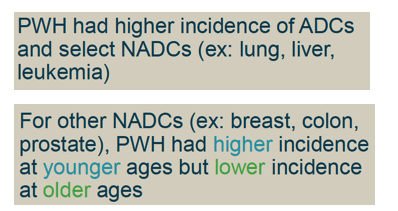
AIDS-defining cancers-cervical cancer, Kaposi sarcoma, and non-Hodgkin lymphoma-develop disproportionately in people with HIV infection. And previous work established that certain non-AIDS-defining cancers-anal cancer and Hodgkin lymphoma-also disproportionately affect people with HIV. A new study by researchers at the Johns Hopkins Bloomberg School of Public Health now provides evidence that certain other non-AIDS cancers-colon, prostate, and lung cancer-also have a higher incidence in younger HIV-positive Medicaid beneficiaries than in HIV-negative people who use Medicaid. Medicaid is the US public health insurance program for people with low income.
Strengths of this new study include its large size and geographic diversity within the United States, its analysis of data from much of the beneficiaries' adult lives, and its comparison of cancer incidence only in Medicaid users, ensuring a closer-than-usual match between people with and without HIV in socioeconomic status and access to health care. Many HIV epidemiologic studies, the Hopkins researchers observed, compare people with HIV to the general population, even though 40% of people with HIV in the United States use Medicaid.
The analysis considered 43.9 million people enrolled in Medicaid in 2001-2015 in 14 US states: Washington, California, Colorado, Texas, Illinois, Ohio, Pennsylvania, Maryland, New York, Massachusetts, North Carolina, Georgia, Alabama, and Florida. To be included in the study, a person had to be 18 to 64 years old, enrolled in Medicaid for more than 6 months, not enrolled in Medicare, and not have a history of cancer. A 6-month run-in period before each person's baseline date lowered chances that cancer would already be developing in a person when they entered the study group. Follow-up continued until a first cancer diagnosis, death, age 65, loss of enrollment, or the study's closing date.
The researchers considered the three AIDS-defining cancers (cervical cancer, Kaposi sarcoma, non-Hodgkin lymphoma), non-AIDS cancers frequently seen in the general population (breast, colon, head and neck, kidney, larynx, leukemia, liver, lung, oropharynx, pancreatic, prostate), non-AIDS cancers frequent in people with HIV (anal, Hodgkin lymphoma), and, as a group, infection-related non-AIDS cancers.
The Hopkins team estimated cumulative incidence of a first cancer by HIV status at baseline, accounting for death and incidence of other cancer types as competing risks.
The analysis included 43,925,817 Medicaid beneficiaries, 181,030 of them with HIV. Median age was older in the HIV group (42 vs 28), and smaller proportions of the HIV group were women (35.8% vs 64.8%), white (23.7% vs 32.6%), Hispanic (10.5% vs 32.6%), and Asian/Pacific Islander (1.6% vs 7.1%). A higher proportion of the HIV group was black (47.7% vs 17.4%). 47.7% of PLWH were non-Hispanic Black, 23.7% non-Hispanic White, 10.5% Hispanic. While those without HIV 17.4% ere non-Hispanic Black and 32.6% Hispanic, and 32.6% non-Hispanic White.
The five most common site-specific cancers in all women were breast, lung, leukemia, colon, and non-Hodgkin lymphoma, and in men prostate, lung, head and neck, liver, and colon. Among women, cumulative incidence of combined non-AIDS-defining cancers was always higher regardless of age in women with HIV. The same was true for lung cancer, leukemia, and non-Hodgkin lymphoma. Colon cancer incidence was higher in women with HIV until around age 65, when incidence became higher in women without HIV. Breast cancer incidence was similar in women with and without HIV until about age 45, when incidence became higher in women without HIV.
Among men, cumulative incidence of combined non-AIDS-defining cancers was always higher in men with HIV, regardless of age, as was incidence of liver cancer. Cumulative incidence of prostate cancer was marginally higher in men with HIV until age 55, when incidence became higher in men without HIV. The same crossover pattern held true for lung cancer incidence, which was higher in men with HIV until age 60; head and neck cancer incidence, which was higher in men with HIV until age 60; and colon cancer, which was higher in men with HIV until age 55.
For pancreatic cancer, people with HIV had higher cumulative incidence than people without HIV at younger ages but lower incidence at older age.
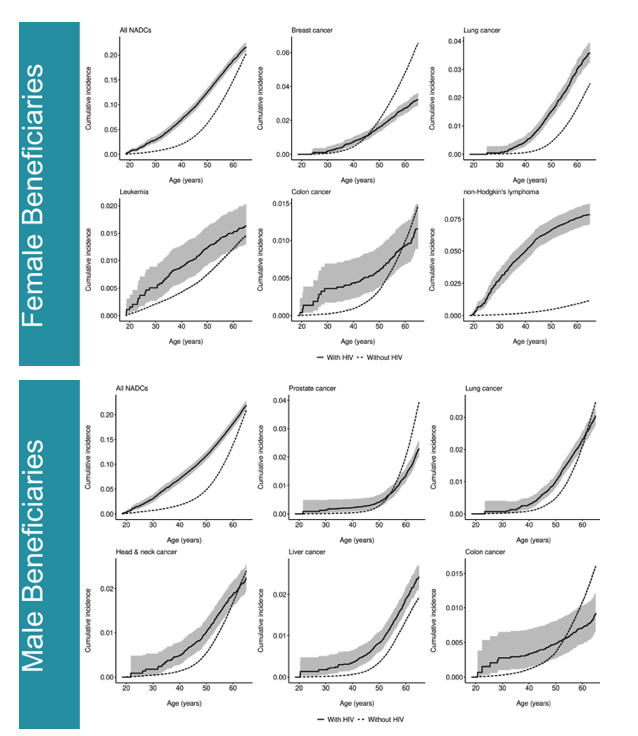
The Hopkins investigators believe their findings "highlight the importance of monitoring people living with HIV for both AIDS-defining cancers and non-AIDS-defining cancers" throughout their adult life. Clinicians should not minimize the threat of breast, prostate, lung, pancreatic, and colon cancer in people with HIV, especially younger people.
Incidence of AIDS-defining cancers, non-AIDS-defining cancers, and death by HIV status in all eligible Medicaid beneficiaries, 2001-2015......blue lines are death

Reference
1. Rudolph JE, Calkins K, Lau B, Joshu C. Incidence of cancer among Medicaid beneficiaries with and without HIV: 2001-2015. 30th CROI, Conference on Retroviruses and Opportunistic Infections, February 19-22, 2023, Seattle. Abstract 155.

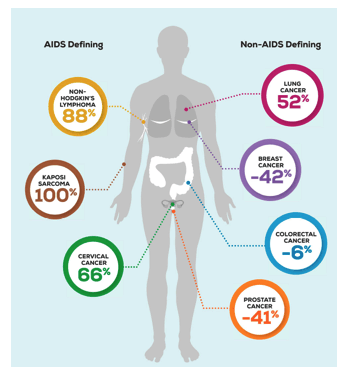
program abstract
Background: Life expectancy among people living with HIV (PLH) is approaching the general population, and chronic conditions associated with aging-including cancer-are increasingly relevant. Among PLH, incidence of AIDS-defining cancers (ADCs) has decreased, and the cancer burden has shifted toward non-AIDS-defining cancers (NADCs). Medicaid provides insurance for 40% of PLH in the US and may offer a better comparator group for PLH than the general population. Thus, we compared the incidence of cancer among Medicaid beneficiaries with and without HIV.
Methods: We used data on Medicaid beneficiaries enrolled in 14 US states in 2001-2015. We included beneficiaries aged 18-64 years, who had >6 months of continual enrollment in Medicaid without dual enrollment in Medicare. We excluded beneficiaries with a history of cancer prior to baseline. We estimated cumulative incidence of first cancer by HIV status at baseline, with age as the time scale, accounting for death and incidence of other cancer types as competing risks. Cancer types examined included all ADCs (Kaposi's sarcoma, cervical, and non-Hodgkin's lymphoma) and NADCs that are high burden in the general population (breast, colon, head/neck, kidney, larynx, leukemia, liver, lung, oropharynx, pancreatic, prostate) and among PLH (anal, Hodgkin's lymphoma). We estimated cumulative incidence overall and stratified by sex, race/ethnicity, and calendar period.
Results: We included 43,925,817 beneficiaries in the analysis, of whom 181,030 had HIV. Across all ages, beneficiaries with HIV had a higher incidence of ADCs, as well as some NADCs (lung, leukemia, head and neck, liver, oropharynx, larynx, and anal cancer). Breast cancer incidence was similar until age 42, after which beneficiaries without HIV had a higher incidence. For colon, prostate, and pancreatic cancers, beneficiaries with HIV had higher incidence at younger ages; at older ages, incidence was similar or higher among beneficiaries without HIV.
Conclusion: We compared cancer incidence by HIV status within a geographically diverse sample of Medicaid beneficiaries. We examined incidence across much of the beneficiaries' adult lives, allowing us to see trends in how incidence of cancers (especially NADCs) varied by HIV status and age. Our findings may suggest an increased risk of certain NADCs (e.g., colon, head/neck, and leukemia) at younger ages among PLH, even when compared against other Medicaid beneficiaries,

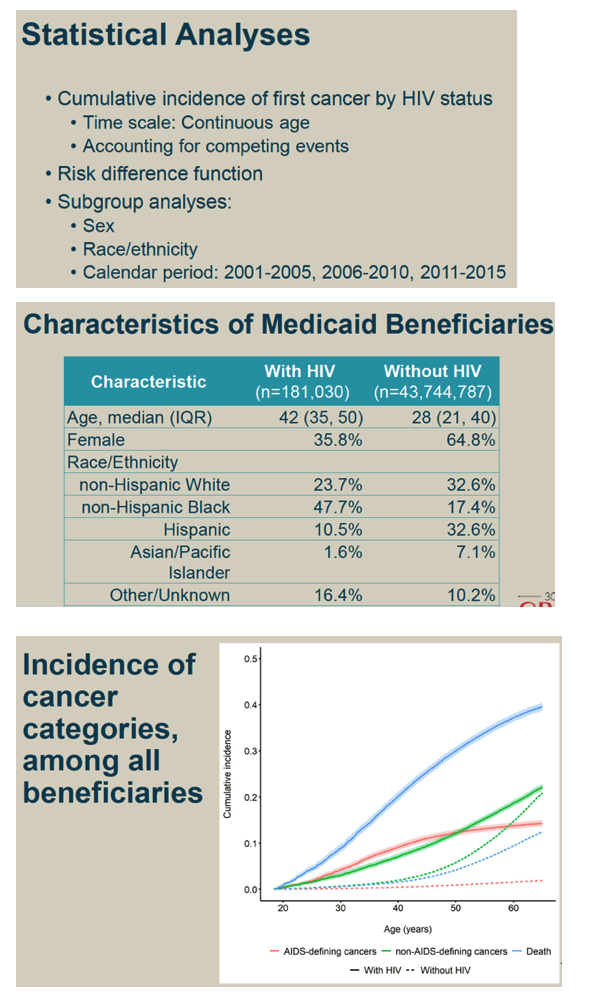

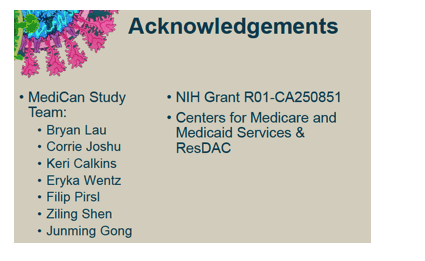
|
| |
|
 |
 |
|
|